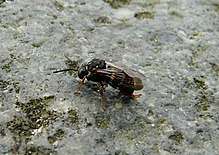Epeolus
Epeolus is a genus of cuckoo bees of the tribe Epeolini, the subfamily Nomadinae part of the honey bee family Apidae.[1] They are often known as variegated cuckoo-bees.
| Epeolus | |
|---|---|
.jpg) | |
| Epeolus australis | |
| Scientific classification | |
| Kingdom: | Animalia |
| Phylum: | Arthropoda |
| Class: | Insecta |
| Order: | Hymenoptera |
| Family: | Apidae |
| Tribe: | Epeolini |
| Genus: | Epeolus Latreille, 1802 |
| Type species | |
| Epeolus variegatus (Linnaeus, 1758) | |
| Species | |
|
see text | |

Biology
The species within Epeolus are medium-sized bees with bright patterns. There are currently approximately 100 species described from throughout the world. All known species of Epeolus are cleptoparasites of mining bees of the genus Colletes. The female enters the nesting excavated by the female Colletes bee and lays an egg in an unsealed cell. The Epeolus larva then consumes the egg of the host bee and then feeds on the pollen the Colletes bee provisioned the cell with for her offspring. Epeolus bees may be rather obvious and easily observed in the vicinity of the nesting aggregations of their hosts and often use the same flowers to feed on.[2] Colletes bees line their nesting cells with a cellophane like covering which they exude from the Dufour's gland to protect the cell from moisture and fungal infection,[3] female Epeolus bees have spines on the end of their abdomens which they use to pierce u-shaped holes in this covering so that she can oviposit between its layers, she also secretes a small amount of glue so that the egg adheres to the cell.[4]
Species
The following species are currently classified in the genus Epeolus:[5]
- Epeolus ainsliei Crawford, 1932
- Epeolus alatus Friese, 1922
- Epeolus alpinus Friese, 1893
- Epeolus amabilis Gerstäcker, 1869
- Epeolus americanus (Cresson, 1878)
- Epeolus anticus (Walker, 1871)
- Epeolus arciferus Cockerell, 1924
- Epeolus asperatus Cockerell, 1909
- Epeolus asperrima (Moure, 1954)
- Epeolus assamensis Meade-Waldo, 1913
- Epeolus aureovestitus Dours, 1873
- Epeolus australis Mitchell, 1962
- Epeolus autumnalis Robertson, 1902
- Epeolus banksi (Cockerell, 1907)
- Epeolus barberiellus Cockerell, 1907
- Epeolus beulahensis Cockerell, 1904
- Epeolus bifasciatus Cresson, 1864
- Epeolus bischoffi (Mavromoustakis, 1954)
- Epeolus boliviensis Friese, 1908
- Epeolus caffer (Lepeletier, 1841)
- Epeolus canadensis Mitchell, 1962
- Epeolus carioca (Moure, 1954)
- Epeolus carolinus Mitchell, 1962
- Epeolus cestus Eardley, 1991
- Epeolus claripennis Friese, 1908
- Epeolus collaris Pérez, 1895
- Epeolus compactus Cresson, 1878
- Epeolus compar Alfken, 1937
- Epeolus coreanus Yasumatsu, 1933
- Epeolus corniculatus Bischoff, 1923
- Epeolus cruciger (Panzer, 1799)
- Epeolus crucis Cockerell, 1904
- Epeolus diodontus Cockerell, 1934
- Epeolus erigeronis Mitchell, 1962
- Epeolus fallax Morawitz, 1872
- Epeolus fasciatus Friese, 1895
- Epeolus fervidus Smith, 1879
- Epeolus flavociliatus Friese, 1899
- Epeolus flavofasciatus Smith, 1879
- Epeolus floridensis Mitchell, 1962
- Epeolus friesei Brauns, 1903
- Epeolus fulviventris Bischoff, 1923
- Epeolus fulvopilosus Cameron, 1902
- Epeolus fumipennis Say, 1837
- Epeolus gabrielis Cockerell, 1909
- Epeolus gianellii Gribodo, 1894
- Epeolus glabratus Cresson, 1878
- Epeolus hitei Cockerell, 1908
- Epeolus howardi Mitchell, 1962
- Epeolus humillimus Cockerell, 1918
- Epeolus ilicis Mitchell, 1962
- Epeolus intermedius Pérez, 1884
- Epeolus interruptus Robertson, 1900
- Epeolus ishikawai Tadauchi & Schwarz, 1999
- Epeolus japonicus Bischoff, 1930
- Epeolus julliani Pérez, 1884
- Epeolus kristenseni Friese, 1915
- Epeolus lanhami Mitchell, 1962
- Epeolus lectoides Robertson, 1901
- Epeolus lectus Cresson, 1878
- Epeolus luteipennis Friese, 1917
- Epeolus lutzi Cockerell, 1921
- Epeolus melectiformis Yasumatsu, 1938
- Epeolus melectimimus Cockerell & Sandhouse, 1924
- Epeolus mercatus Fabricius, 1804
- Epeolus mesillae (Cockerell, 1895)
- Epeolus minimus (Robertson, 1902)
- Epeolus minutus Radoszkowski, 1888
- Epeolus montanus (Cresson, 1878)
- Epeolus natalensis Smith, 1879
- Epeolus nigra (Michener, 1954)
- Epeolus novomexicanus Cockerell, 1912
- Epeolus odontothorax (Michener, 1954)
- Epeolus olympiellus Cockerell, 1904
- Epeolus peregrinus Cockerell, 1911
- Epeolus pictus Nylander, 1848
- Epeolus pilatei Cockerell, 1924
- Epeolus productulus Bischoff, 1930
- Epeolus productus Bischoff, 1930
- Epeolus pubescens Cockerell, 1937
- Epeolus pulchellus Cresson, 1865
- Epeolus pusillus Cresson, 1864
- Epeolus pygmaeorum Cockerell, 1932
- Epeolus rubrostictus Cockerell & Sandhouse, 1924
- Epeolus rufomaculatus Cockerell & Sandhouse, 1924
- Epeolus rufothoracicus Bischoff, 1923
- Epeolus rufulus Cockerell, 1941
- Epeolus rugosus Cockerell, 1949
- Epeolus schraderi (Michener, 1954)
- Epeolus schummeli Schilling, 1849
- Epeolus scutellaris Say, 1824
- Epeolus siculus Giordani Soika, 1944
- Epeolus sigillatus Alfken, 1930
- Epeolus tarsalis Morawitz, 1874
- Epeolus tibetanus Meade-Waldo, 1913
- Epeolus transitorius Eversmann, 1852
- Epeolus tristicolor Viereck, 1905
- Epeolus tristis Smith, 1854
- Epeolus tsushimensis Cockerell, 1926
- Epeolus variegatus (Linnaeus, 1758)
- Epeolus variolosus (Holmberg, 1886)
- Epeolus vernalis Mitchell, 1962
- Epeolus vinogradovi Popov, 1952
- Epeolus weemsi Mitchell, 1962
- Epeolus zonatus Smith, 1854
References
- "Genus Epeolus Latreille". An Annotated Catalogue of the Bee Species of the Indian Region. Dr. Rajiv K. Gupta. Retrieved 7 July 2017.
- "Epeolus (variegated cuckoo-bees)". Steven Falk. Retrieved 7 July 2017.
- Michael Kuhlmann (2007). "Molecular, biogeographical and phenological evidence for the existence of three western European sibling species in the Colletes succinctus group (Hymenoptera: Apidae)". Organisms Diversity & Evolution. 7 (2): 155–165. doi:10.1016/j.ode.2006.04.001.
- Joseph S. Wilson; Olivia J. Messinger Carril (2015). The Bees in Your Backyard: A Guide to North America's Bees. Princeton. p. 266. ISBN 1400874157.
- "Epeolus Latreille, 1802". Bionames.org. Retrieved 7 July 2017.